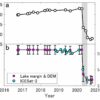A study published in Science Advances reveals that uncertainties are currently too large to accurately predict exact tipping times for critical Earth system components like the Atlantic Meridional Overturning Circulation (AMOC), polar ice sheets, or tropical rainforests.
These tipping events, which might unfold in response to human-caused global warming, are characterized by rapid, irreversible climate changes with potentially catastrophic consequences. However, as the study shows, predicting when these events will occur is more difficult than previously thought.
Climate scientists from the Technical University of Munich (TUM) and the Potsdam Institute for Climate Impact Research (PIK) have identified three primary sources of uncertainty.
First, predictions rely on assumptions regarding the underlying physical mechanisms, as well as regarding future human actions to extrapolate past data into the future. These assumptions can be overly simplistic and lead to significant errors.
Second, long-term, direct observations of the climate system are rare and the Earth system components in question may not be suitably represented by the data. Third, historical climate data is incomplete.
Huge data gaps, especially for the longer past, and the methods used to fill these gaps can introduce errors in the statistics used to predict possible tipping times.
To illustrate their findings, the authors examined the AMOC, a crucial ocean current system. Previous predictions from historical data suggested a collapse could occur between 2025 and 2095. However, the new study revealed that the uncertainties are so large that these predictions are not reliable.
Using different fingerprints and data sets, predicted tipping times for the AMOC ranged from 2050 to 8065 even if the underlying mechanistic assumptions were true. Knowing that the AMOC might tip somewhere within a 6,000-year window isn’t practically useful, and this large range highlights the complexity and uncertainty involved in such predictions.
The researchers conclude that while the idea of predicting climate tipping points is appealing, the reality is fraught with uncertainties. The current methods and data are not up to the task.
“Our research is both a wake-up call and a cautionary tale,” says lead author Maya Ben-Yami. “There are things we still can’t predict, and we need to invest in better data and a more in-depth understanding of the systems in question. The stakes are too high to rely on shaky predictions.”
While the study by Ben-Yami and colleagues shows that we cannot reliably predict tipping events, the possibility of such events cannot be ruled out either. The authors also stress that statistical methods are still very good at telling us which parts of the climate have become more unstable. This includes not only the AMOC, but also the Amazon rainforest and ice sheets.
“The large uncertainties imply that we need to be even more cautious than if we were able to precisely estimate a tipping time. We still need to do everything we can to reduce our impact on the climate, first and foremost by cutting greenhouse gas emissions. Even if we can’t predict tipping times, the probability for key Earth system components to tip still increases with every tenth of a degree of warming,” concludes co-author Niklas Boers.
More information:
Maya Ben-Yami et al, Uncertainties too large to predict tipping times of major Earth system components from historical data, Science Advances (2024). DOI: 10.1126/sciadv.adl4841. www.science.org/doi/10.1126/sciadv.adl4841
Provided by
Technical University Munich
Citation:
Not the day after tomorrow: Why we can’t predict the timing of climate tipping points (2024, August 2)



